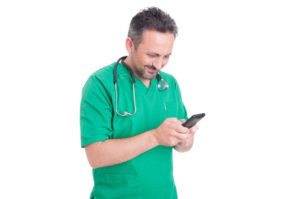
Don’t be surprised, if after cosmetic plastic surgery, your surgeon tells you to keep your smart phone charged and ready when you go home.
Why?
A recent study asking 57 after surgery patients to use their smart phones at home for follow-up care shows the concept could spread.
Plastic Surgeon James E. Zins, M.D., chairman of the Cleveland Clinic’s Department of Plastic Surgery asked the study patients on discharge to take smart phone pictures of their surgical sites within 48 to 72 hours after surgery.
(The smart phone protocol is printed in the current issue of Aesthetic Surgery Journal, a professional magazine for plastic surgeons.)
Normally, surgeons routinely check surgical sites for infections first thing the morning after surgery.
Read more about cosmetic surgical infections.
The 57 patients had a range of procedures including:
- Face and Neck Llift
- Blepharoplasty
- Brow Lift
- Liposuction of the jaw line and neck.
Dr. Zins asked the study subjects to also keep a short record of their after surgery and smart phone experiences.
Results? The surgeon discovered three infections during the test period. Fifty-two patients responded to a survey about the test, meaning 96.2 percent of the subjects gave a thumbs up.
Said Dr. Zins: “I also use the smart phone protocol for breast and body contouring surgery.
“Complications following facial surgery are usually obvious so we’ve found the patient “selfies” are enough to detect early post-op problems.
“If the problem is not crystal clear, we quickly see the patient in person.”
For body contouring problems, a second person often takes the photos.
Dr. Zins says the point of the selfie program is making contact with patients earlier – within two to three days — than typical follow-up visits.
While helpful, the program never takes the place of actual postoperative visits when needed or required, according to Dr. Zins.
The point of the selfie program is to:
- Reassure patients and allay any fears about post-op problems.
- Recognize early problems before they become any larger.
Patients probably also appreciate the savings of their own time and schedules.
Instructions for the after-surgery selfies are
- A close up front view of the face
- A both a right and left view from the side
With more and more people carrying cell phones – which are constantly improving their cameras – more cosmetic plastic surgeons might be reducing follow-up, in-person infection visits by using patient smart phone pictures where possible.

